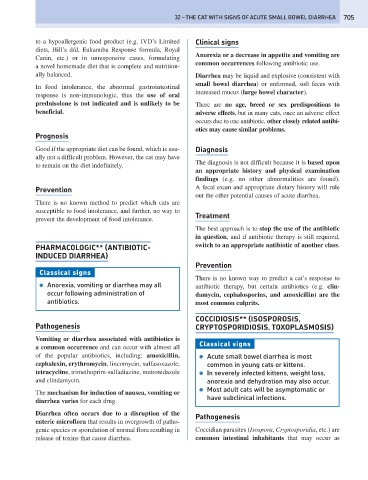Page 713 - Problem-Based Feline Medicine
P. 713
32 – THE CAT WITH SIGNS OF ACUTE SMALL BOWEL DIARRHEA 705
to a hypoallergenic food product (e.g. IVD’s Limited Clinical signs
diets, Hill’s d/d, Eukanuba Response formula, Royal
Anorexia or a decrease in appetite and vomiting are
Canin, etc.) or in unresponsive cases, formulating
common occurrences following antibiotic use.
a novel homemade diet that is complete and nutrition-
ally balanced. Diarrhea may be liquid and explosive (consistent with
small bowel diarrhea) or unformed, soft feces with
In food intolerance, the abnormal gastrointestinal
increased mucus (large bowel character).
response is non-immunologic, thus the use of oral
prednisolone is not indicated and is unlikely to be There are no age, breed or sex predispositions to
beneficial. adverse effects, but in many cats, once an adverse effect
occurs due to one antibiotic, other closely related antibi-
otics may cause similar problems.
Prognosis
Good if the appropriate diet can be found, which is usu- Diagnosis
ally not a difficult problem. However, the cat may have
The diagnosis is not difficult because it is based upon
to remain on the diet indefinitely.
an appropriate history and physical examination
findings (e.g. no other abnormalities are found).
Prevention A fecal exam and appropriate dietary history will rule
out the other potential causes of acute diarrhea.
There is no known method to predict which cats are
susceptible to food intolerance, and further, no way to
Treatment
prevent the development of food intolerance.
The best approach is to stop the use of the antibiotic
in question, and if antibiotic therapy is still required,
PHARMACOLOGIC** (ANTIBIOTIC- switch to an appropriate antibiotic of another class.
INDUCED DIARRHEA)
Prevention
Classical signs
There is no known way to predict a cat’s response to
● Anorexia, vomiting or diarrhea may all antibiotic therapy, but certain antibiotics (e.g. clin-
occur following administration of damycin, cephalosporins, and amoxicillin) are the
antibiotics. most common culprits.
COCCIDIOSIS** (ISOSPOROSIS,
Pathogenesis CRYPTOSPORIDIOSIS, TOXOPLASMOSIS)
Vomiting or diarrhea associated with antibiotics is
Classical signs
a common occurrence and can occur with almost all
of the popular antibiotics, including: amoxicillin, ● Acute small bowel diarrhea is most
cephalexin, erythromycin, lincomycin, sulfasoxazole, common in young cats or kittens.
tetracycline, trimethoprim-sulfadiazine, metronidazole ● In severely infected kittens, weight loss,
and clindamycin. anorexia and dehydration may also occur.
● Most adult cats will be asymptomatic or
The mechanism for induction of nausea, vomiting or
have subclinical infections.
diarrhea varies for each drug.
Diarrhea often occurs due to a disruption of the
Pathogenesis
enteric microflora that results in overgrowth of patho-
genic species or sporulation of normal flora resulting in Coccidian parasites (Isospora, Cryptosporidia, etc.) are
release of toxins that cause diarrhea. common intestinal inhabitants that may occur as

